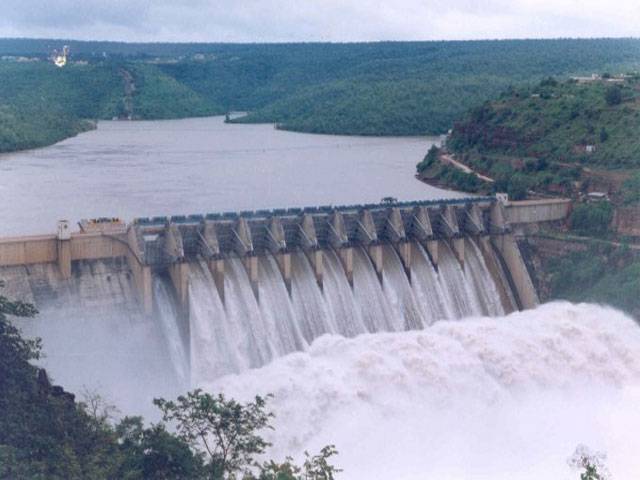ISLAMABAD - The Indus River System Authority (Irsa) has forewarned the provinces about the expected water shortage in next couple of days as the river inflows have been reduced by 122,200 cusecs.
“The storage and river inflows are decreasing in the wake of falling temperatures in the catchments. Skardu temperature, after touching the peak of 34.4 degree Celsius on June 5, has fallen to 22.8 degree Celsius, impacting the river inflows badly,” said Irsa spokesman Khalid Rana in an interaction with media persons. He further said that as Irsa has started releasing water from the storage to augment the river supplies, both the reservoirs are depleting. And after touching the peak storage of 2.180MAF on June 18, it fell to 1.884 MAF today (Saturday). He stated that the river inflows, after touching the peak flows of 378,400 cusecs, decreased to 256,200 cusecs today.
The Irsa forewarned the provinces about the water situation by writing a letter on Friday, he added. Sharing details, the spokesperson said a major operational constraint is being faced by Irsa on Tarbela which cannot be depleted more than 4 ft per day for safety reasons. So the Punjab was informed that Irsa would reduce transfer of water from the Indus to JC (Jhelum-Chenab) zone, he averred. Resultantly, the Irsa reduced release of water CJ Link Canal from 18,000 cusecs to 15,000 cusecs. Similarly, the Irsa has increased supplies from Mangla Dam from 25,000 cusecs to 40,000 cusecs immediately to avoid any shortfall to Punjab Trimmu Canal System as a result of reduction in the CJ flows. The River Chenab, also touching a peak flow of 74,900 cusecs on 10th June, has decreased to 39,000 cusecs. The increase in Mangla will also compensate the reduction of the River Chenab, the spokesperson affirmed.
“The Irsa only tried to manage the available resource by switching between Indus and JC zones and still no cut is imposed on any of the stakeholders,” Khalid Rana said. However, if the situation continues for next 24/48 hours, the Irsa may impose an initial cut of 5pc to 10pc to Punjab and Sindh on their indents, he added.
Depletion of reservoirs especially Mangla at this critical stage is very detrimental but IRSA in connivance with the provinces decided to release full supplies to provinces till possibility. Punjab is receiving 131,000 cusecs water, Sindh 165,000 cusecs, Balochistan 14,000 cusecs and Khyber Pakhunkhawa 3300 cusecs water.
The spokesperson hoped that a pre monsoon system is expected at the end of next week which may improve the water in unregulated rivers i.e Kabul and Chenab resultantly IRSA will again switch to storage of waters in reservoirs.
The position of the river inflows and outflows at Tarbela, Mangla and Chashma along with the reservoir levels and the barrages today is as under: Indus at Tarbela: inflow 126,400 cusecs and outflow 172,900 cusecs. Kabul at Nowshera: inflow 61,200 cusecs and outflow 61,200 cusecs. Jhelum at Mangla: inflow 29,300 cusecs and outflow 40,000 cusecs. Chenab at Marala: inflow 39,300 cusecs and outflow 11,500 cusecs.
Barrages: Jinnah: inflow 225,300 cusecs and outflow 217,300 cusecs, Chashma: inflow 228,800 cusecs and outflow 207,000 cusecs, Taunsa: inflows 215,200 cusecs and outflow 187,200 cusecs, Panjnad: inflow 12,500 cusecs and outflow nil. Guddu: inflow 135,800 cusecs and outflow 105,600 cusecs, Sukkur: inflow 86,600 cusecs and outflow 40,100, Kotri: inflow 16,300 cusecs and outflow nil.
Reservoirs level and storage: Tarbela: Minimum operating level, 1,386 feet, present level 1,434.28 feet, maximum conservation level 1,550 feet, live storage today 0.900 million acres feet (MAF).
Mangla: Minimum operating level 1,050 feet, present level 1,123.25 feet, maximum conservation level 1,242 feet, live storage today 0.876MAF. Chashma: minimum operating level 638.15 feet, present level 644.30 feet, maximum conservation level 649 feet, live storage today 0.107MAF. The inflow and outflow of the River Indus at Tarbela and Chashma, the River Kabul at Nowshera and the River Jhelum at Mangla have been reflected as mean flows of 24 hours, whereas the other flows have been gauged at 6.00 am.






